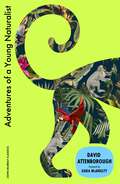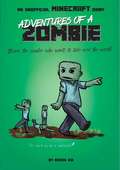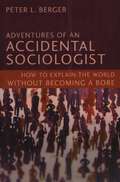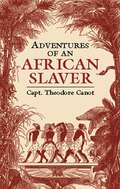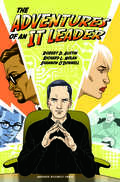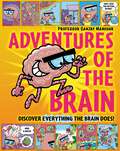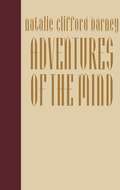- Table View
- List View
Adventures of a Terribly Greedy Girl: A Memoir of Food, Family, Film & Fashion
by Kay Plunkett-HoggeWith a dry martini in hand, Kay Plunkett-Hogge looks back at the happy accidents, regrettable errors and unexpected opportunities that led to a career as a food and drink writer, via stints in the worlds of fashion and film. It is a celebration of a tumbling through life, of mistakes, and opportunities laid bare. As you read, Kay shares 25 delicious recipes she discovered along the way, from her grandmother's apple crumble to sashimi with Thai salsa verde. Chapters include 10 Things I Learnt in New York, The Comfort of a Roast Chicken and What Would Martha Do? Joyful, witty and occasionally indiscreet, Adventures of A Terribly Greedy Girl is about the benefits of letting your curiosity trump your good sense.
Adventures of a Transplanted Gardener: Advice for New Florida Gardeners
by Ginny StiboltA starter guide to cultivating plants that flourish in Florida Ideal for gardeners new to Florida and residents who want to try their hands at gardening for the first time, this starter guide helps readers learn to grow plants in the state’s unique natural environment. Botanist and lifelong gardener Ginny Stibolt shares helpful stories, advice, and tips from her own experience moving to Florida, where she discovered that the rules she had followed did not apply.Stibolt tells readers what they can do to avoid the beginner mistakes she made and dispels common misconceptions about which plants to grow and how to grow them in Florida. Introducing Florida’s water features, natural areas, and native plant communities, Stibolt shows what a “Real Florida” landscape looks like and explains how working with this knowledge makes gardening easier and more successful. She explores useful topics including gardening for birds and butterflies, growing food, composting, and stormwater management. Stibolt also points to resources for digging deeper into these and related subjects based on the reader’s needs and location within the state.Full of friendly, reliable, and commonsense expertise, Adventures of a Transplanted Gardener sets aspiring growers on the fast track to cultivating plants that flourish in Florida. This book is the perfect resource for anyone interested in the challenges, rewards, and beauty of gardening in the Sunshine State.
Adventures of a Tropical Tramp
by Harry La Tourette FosterThe Adventures of a Tropical Tramp, first published in 1922, is the first of several travel narratives by Harry La Tourette Foster (1894-1932), a World War One veteran who, seized by wanderlust, would spend much of his adult life traveling and working first in South America (the subject of this book), and later in Asia, the South Pacific, and the Caribbean. While in South America, Foster recounts his experiences as a miner, reporter, war correspondent, diplomatic attaché, guide, companion, and piano player, ending with an extended voyage down the Amazon and its tributaries. His writing vividly - and often humorously - portrays the people he met, the local culture, and his desire for new adventures. Included are 4 pages of photographs.
Adventures of a Verbivore
by Richard LedererLed by a self-proclaimed verbivore--someone who makes a daily diet of words--this journey through the marvels and complexities of the English language celebrates oxymorons, confusables, and anagrams.
Adventures of a Wonky Eyed Boy
by Jason ByrneIt was a time when your brother persuaded you to eat the grease behind the cooker by telling you it was caramel, your house was blown up by lightning, your dad mixed up the toothpaste and the 'arse-cream', and you fell asleep on Sunday nights to the sound of one of the neighbours - who were all named Paddy - drunkenly singing 'Magic Moments' in the good front room. All of this while trying to stop your wonky eye from giving the game away.With illustrations by the award-winning Nicky Phelan, Jason Byrne's Adventures of a Wonky-eyed Boy is a unique memoir capturing the childhood adventures of an accident-prone youngster in suburban Ireland. It's like Angela's Ashes on amphetamines!
Adventures of a Young Man
by John Dos PassosThe novel chronicles Glenn's disillusionment with American culture and Communist movements. He finds the society repressive, and his career in banking confirms his fear that the dominant culture is indifferent to the suffering of the poor.
Adventures of a Young Man: A Novel
by John Dos PassosIn a novel that closely parallels author John Dos Passos's own ideological struggles during the Spanish Civil War, protagonist Glenn Spotswood, an American, travels to Spain to fight on the Republican side. There, Spotswood joins the Communist Party to help establish a more just society, but his idealism quickly degrades under the stress of party orthodoxy and hypocrisy.
Adventures of a Young Naturalist: SIR DAVID ATTENBOROUGH'S ZOO QUEST EXPEDITIONS
by Sir David AttenboroughTHE SUNDAY TIMES BESTSELLER'A great book for anyone who wants to vicariously travel like an old-fashioned adventurer and seeks to understand how far we have come in developing a protective attitude to wildlife' New York Times'A marvellous book ... unputdownable ... utterly engaging' TelegraphIn 1954, a young television presenter named David Attenborough was offered the opportunity of a lifetime - to travel the world finding rare and elusive animals for London Zoo's collection, and to film the expeditions for the BBC. Now 'the greatest living advocate of the global ecosystem' this is the story of the voyages that started it all. Staying with local tribes while trekking in search of giant anteaters in Guyana, Komodo dragons in Indonesia and armadillos in Paraguay, he and the rest of the team battled with cannibal fish, aggressive tree porcupines and escape-artist wild pigs, as well as treacherous terrain and unpredictable weather, to record the incredible beauty and biodiversity of these regions. The methods may be outdated now, but the fascination and respect for the wildlife, the people and the environment - and the importance of protecting these wild places - is not.Written with his trademark wit and charm, Adventures of a Young Naturalist is not just the story of a remarkable adventure, but of the man who made us fall in love with the natural world, and who is still doing so today.
Adventures of a Young Naturalist: SIR DAVID ATTENBOROUGH'S ZOO QUEST EXPEDITIONS
by Sir David AttenboroughWITH A NEW FOREWORD BY DARA McANULTYTHE SUNDAY TIMES BESTSELLER'His writing is as impressive and as enjoyable as his TV programmes and there can be no higher praise' Daily Express'A marvellous book . . . unputdownable . . . utterly engaging' Daily TelegraphIn 1954, a young television presenter named David Attenborough was offered the opportunity of a lifetime - to travel the world finding rare and elusive animals for London Zoo's collection, and to film the expeditions for the BBC.Now 'the greatest living advocate of the global ecosystem' this is the story of the voyages that started it all. Staying with local tribes while trekking in search of giant anteaters in Guyana, Komodo dragons in Indonesia and armadillos in Paraguay, he and the rest of the team battled with cannibal fish, aggressive tree porcupines and escape-artist wild pigs, as well as treacherous terrain and unpredictable weather, to record the incredible beauty and biodiversity of these regions. The methods may be outdated now, but the fascination and respect for the wildlife, the people and the environment - and the importance of protecting these wild places - is not.Written with his trademark wit and charm, Adventures of a Young Naturalist is not just the story of a remarkable adventure, but of the man who made us fall in love with the natural world, and who is still doing so today.** Praise for Sir David Attenborough **'A great educator as well as a great naturalist' Barack Obama'Sir David is a wizard of television, and, like Gandalf or Dumbledore, he has a near-magical gift for combining warmth and gravitas . . . the man who, for me, exemplifies the best in British broadcasting' Louis Theroux'When I was a young boy I used to love turning on the television and watching David's programmes and really feeling like I was either back out in Africa or I was learning about something magical and almost out of this planet' Prince William
Adventures of a Young Naturalist: SIR DAVID ATTENBOROUGH'S ZOO QUEST EXPEDITIONS
by Sir David AttenboroughWITH A NEW FOREWORD BY DARA McANULTYTHE SUNDAY TIMES BESTSELLER'His writing is as impressive and as enjoyable as his TV programmes and there can be no higher praise' Daily Express'A marvellous book . . . unputdownable . . . utterly engaging' Daily TelegraphIn 1954, a young television presenter named David Attenborough was offered the opportunity of a lifetime - to travel the world finding rare and elusive animals for London Zoo's collection, and to film the expeditions for the BBC.Now 'the greatest living advocate of the global ecosystem' this is the story of the voyages that started it all. Staying with local tribes while trekking in search of giant anteaters in Guyana, Komodo dragons in Indonesia and armadillos in Paraguay, he and the rest of the team battled with cannibal fish, aggressive tree porcupines and escape-artist wild pigs, as well as treacherous terrain and unpredictable weather, to record the incredible beauty and biodiversity of these regions. The methods may be outdated now, but the fascination and respect for the wildlife, the people and the environment - and the importance of protecting these wild places - is not.Written with his trademark wit and charm, Adventures of a Young Naturalist is not just the story of a remarkable adventure, but of the man who made us fall in love with the natural world, and who is still doing so today.** Praise for Sir David Attenborough **'A great educator as well as a great naturalist' Barack Obama'Sir David is a wizard of television, and, like Gandalf or Dumbledore, he has a near-magical gift for combining warmth and gravitas . . . the man who, for me, exemplifies the best in British broadcasting' Louis Theroux'When I was a young boy I used to love turning on the television and watching David's programmes and really feeling like I was either back out in Africa or I was learning about something magical and almost out of this planet' Prince William
Adventures of a Young Naturalist: The Zoo Quest Expeditions
by David AttenboroughIn 1954, David Attenborough, a young television presenter, was offered the opportunity of a lifetime--to travel the world finding rare and elusive animals for the London Zoo's collection, and to film the expedition for the BBC for a new show called Zoo Quest.This is the story of those voyages. Staying with local tribes while trekking in search of giant anteaters in Guyana, Komodo dragons in Indonesia, and armadillos in Paraguay, he and the rest of the team contended with cannibal fish, aggressive tree porcupines, and escape-artist wild pigs, as well as treacherous terrain and unpredictable weather, to record the incredible beauty and biodiversity of these regions. Written with his trademark wit and charm, Adventures of a Young Naturalist is not just the story of a remarkable adventure, but of the man who made us fall in love with the natural world and taught us the importance of protecting it--and who is still doing so today.
Adventures of a Young Volcano (Fountas & Pinnell Classroom, Guided Reading)
by Gideon Kendall Elizabeth RuschVolcanoes grow and change over thousands and thousands of years. A young volcano named Squirt is ready to grow up, but he'll have to do some serious erupting before he's as big as he wants to be.
Adventures of a Zombie: An Unofficial Minecraft Diary (Minecraft #3)
by Books KidFollow the adventures of Bern the Zombie, the leader of the greatest zombie army in Minecraftian history, in this humorous, illustrated chapter book diary.It has taken years of determination, but finally the Bern the Zombie has assembled the largest army of zombies that Minecraftia has ever seen. What exactly does Bern plan to do with his army? Take over the Overworld, of course! But Bern is the first to admit that most zombies aren&’t terribly bright. For instance, they have trouble with basic things, like knowing their left from their right. Read every hilarious misstep of Bern&’s quest in Adventures of a Zombie, an unofficial Minecraft chapter book diary with black-and-white illustrations.
Adventures of a young rifleman in the French and English armies,: during the war in Spain and Portugal, from 1806 to 1816. Written by himself
by Johann Christian MaempelDuring the Napoleonic Wars, few had such an unenviable job as the "poor bloody infantry"; fodder for cannon, unless tightly packed in ranks prey to cavalry, their only recourse was discipline and a highly inaccurate musket. As tactics evolved, the infantry would look for ways to maximize their effectiveness and minimize their own casualties. Increasingly the swift, the crafty and the most capable soldiers took to becoming skirmishers plying their trade away from the lines of death, fighting a personal war between the lines behind whatever cover they could find. In Wellington's ranks, many of these skirmishers were armed with the highly accurate but relative slow-loading Baker rifle; feared by their French opponents, the riflemen were not all British but also recruited from the ranks of the German principalities that Napoleon had pressed into his armies. One such soldier was Joseph Maempel: forced away from his native Germany to fight for the French, he was captured early in his career and decided to join the allied cause. After many escapes, scrapes, adventures and much hard fighting, the author returned to his native lands to write his book. The world famous German author and poet Goëthe volunteered to edit these memoirs, which contain an excellent account of the service of the young Rifleman across the battle-fields of Europe.Author -- Johann Christian MaempelEditor - Johann Wolfgang von Goëthe (1749 -1832)Text taken, whole and complete, from the edition published in London, H. Colburn, 1826.Original Page Count - 363 p.
Adventures of an Accidental Sociologist: How to Explain the World Without Becoming a Bore
by Peter L. BergerPeter L. Berger is arguably the best-known American sociologist living today. Since the 1960s he has been publishing books on many facets of the American social scene, and several are now considered classics. So it may be hard to believe Professor Berger's description of himself as an "accidental sociologist." But that in fact accurately describes how he stumbled into sociology. In this witty, intellectually stimulating memoir, Berger explains not only how he became a social scientist, but the many adventures that this calling has led to. Rather than writing an autobiography, he focuses on the main intellectual issues that motivated his work and the various people and situations he encountered in the course of his career. Full of memorable vignettes and colorful characters depicted in a lively narrative often laced with humor, Berger's memoir conveys the excitement that a study of social life can bring. The first part of the book describes Berger's initiation into sociology through the New School for Social Research, "a European enclave in the midst of Greenwich Village bohemia." Berger was first a student at the New School and later a young professor amidst a clique of like-minded individuals. There he published The Social Construction of Reality (with colleague Thomas Luckmann), one of his most successful books, followed by The Sacred Canopy on the sociology of religion, also still widely cited. The book covers Berger's experience as a "globe-trekking sociologist" including trips to Mexico, where he studied approaches to Third World poverty; to East Asia, where he discovered the potential of capitalism to improve social conditions; and to South Africa, where he chaired an international study group on the future of post-Apartheid society. Berger then tells about his role as the director of a research center at Boston University. For over two decades he and his colleagues have been tackling such important issues as globalization, the secularization of Europe, and the ongoing dialectic between relativism and fundamentalism in contemporary culture. What comes across throughout is Berger's boundless curiosity with the many ways in which people interact in society. This book offers longtime Berger readers as well as newcomers to sociology proof that the sociologist's attempt to explain the world is anything but boring.
Adventures of an African Slaver (African American)
by Captain Theodore CanotGrim account by a former slave ship captain describes the apalling machinery of the commercial slave trade, including the harems and "factories" maintained by slavers, treatment and discipline of black Africans on slave ships, the suppression of slave revolts at sea, and much more. Republication of the classic 1854 edition.
Adventures of an Ender Dragon: An Unofficial Minecraft Diary (Unofficial Minecraft Diaries #4)
by Books KidJoin Ember the Ender Dragon on her unexpected sightseeing adventure to the Overworld in this humorous, illustrated, chapter-book diary based on the Minecraft video game series.Ember the Ender Dragon is very bored with her life in the End and dreams of adventure. When Dirk arrives from the Overworld, instead of trying to defeat Ember like other humans have, he offers to take her sightseeing in his world. Ember can&’t resist what sounds like the trip of a lifetime! From snow-covered mountains to the steamy jungle, Dirk shows Ember everything the Overworld has to offer. But something starts to seem fishier than the meal Dirk catches for them. Was Ember too quick to trust her tour guide? With illustrations throughout and humor meant to appeal to Minecraft fans, this fourth book in the Unofficial Minecraft Diary series continues the adventure of exploration.
Adventures of an It Leader
by Robert D. Austin Richard L. Nolan Shannon O'DonnellBecoming an effective IT manager presents a host of challenges--from anticipating emerging technology to managing relationships with vendors, employees, and other managers. A good IT manager must also be a strong business leader.This book invites you to accompany new CIO Jim Barton to better understand the role of IT in your organization. You'll see Jim struggle through a challenging first year, handling (and fumbling) situations that, although fictional, are based on true events.You can read this book from beginning to end, or treat is as a series of cases. You can also skip around to address your most pressing needs. For example, need to learn about crisis management and security? Read chapters 10-12. You can formulate your own responses to a CIO's obstacles by reading the authors' regular "Reflection" questions.You'll turn to this book many times as you face IT-related issues in your own career.
Adventures of the Artificial Woman
by Thomas BergerFed up with the sarcastic, opinionated, and disrespectful women he comes across, Ellery Pierce decides his only choice is to build the perfect woman. A technician at an animatronics firm, Ellery has the experience and tools ready at his fingertips. After years of experiments and fine-tuning, Ellery feels he finally has created an artificial woman who can pass as real -- Phyllis. According to Ellery, Phyllis is the perfect wife, fulfilling his every wish, from gourmet meals to sexual pleasure. Unfortunately for Ellery, he may have made her too closely in his image for his own good: Phyllis leaves Ellery with dreams of Hollywood. Soon she's a bona fide box office sensation. But then Phyllis sets her sights on the ultimate goal -- presidency of the United States. It's no surprise when Phyllis wins the election, but Ellery rightly begins to wonder if this time she's gone too far.
Adventures of the Brain: What the brain does and how it works (Adventures of the Brain)
by Professor Sanjay ManoharA funny, accessible and unique guide to everything the brain is and does, told through comic strip adventures and written by Professor Sanjay Manohar, leading expert in Neuroscience.Learn all about the most mysterious organ in the human body - the Brain! Adventures of the Brain is a bumper book that follows the everyday escapades of a brain character to explain the brain's key functions and concepts such as how we remember, learn new skills or even move our bodies! Also discover how we concentrate, handle pain, plan ahead and communicate and the many billions of neurons that make all this possible. Each cartoon strip adventure is followed by a visually-led information spread to consolidate the learning and reinforce how things work. A Perfect fit for children 8+ and all curious and inquisitive minds.
Adventures of the Mad Monk Ji Gong
by Guo XiaotingFollow the brilliant and hilarious adventures of a mad Zen Buddhist monk who rose from humble beginnings to become one of China's greatest folk heroes! Ji Gong studied at the great Ling Yin monastery, an immense temple that still ranges up the steep hills above Hangzhou, near Shanghai. The Chan (Zen) Buddhist masters of the temple tried to instruct Ji Gong in the spartan practices of their sect, but the young monk, following in the footsteps of other great ne'er-do-wells, distinguished himself mainly by getting expelled. He left the monastery, became a wanderer with hardly a proper piece of clothing to wear, and achieved great renown-in seedy wine shops and drinking establishments! This could have been where Ji Gong's story ended. But his unorthodox style of Buddhism soon made him a hero for popular storytellers of the Song dynasty era. Audiences delighted in tales where the mad old monk ignored-or even mocked-authority, defied common sense, never neglected the wine, yet still managed to save the day. Ji Gong remains popular in China even today, where he regularly appears as the wise old drunken fool in movies and TV shows. In Adventures of the Mad Monk Ji Gong, you'll read how he has a rogue's knack for exposing the corrupt and criminal while still pursuing the twin delights of enlightenment and intoxication. This literary classic of a traveling martial arts master, fighting evil and righting wrongs, will entertain Western readers of all ages!
Adventures of the Mad Monk Ji Gong
by Victoria Cass Guo Xiaoting John Robert ShawFollow the brilliant and hilarious adventures of a mad Zen Buddhist monk who rose from humble beginnings to become one of China's greatest folk heroes!Ji Gong studied at the great Ling Yin monastery, an immense temple that still ranges up the steep hills above Hangzhou, near Shanghai. The Chan (Zen) Buddhist masters of the temple tried to instruct Ji Gong in the spartan practices of their sect, but the young monk, following in the footsteps of other great ne'er-do-wells, distinguished himself mainly by getting expelled. He left the monastery, became a wanderer with hardly a proper piece of clothing to wear, and achieved great renown-in seedy wine shops and drinking establishments!This could have been where Ji Gong's story ended. But his unorthodox style of Buddhism soon made him a hero for popular storytellers of the Song dynasty era. Audiences delighted in tales where the mad old monk ignored-or even mocked-authority, defied common sense, never neglected the wine, yet still managed to save the day. Ji Gong remains popular in China even today, where he regularly appears as the wise old drunken fool in movies and TV shows. In Adventures of the Mad Monk Ji Gong, you'll read how he has a rogue's knack for exposing the corrupt and criminal while still pursuing the twin delights of enlightenment and intoxication. This literary classic of a traveling martial arts master, fighting evil and righting wrongs, will entertain Western readers of all ages!
Adventures of the Mind from the Saturday Evening Post
by Richard Thruelsen John KoblerTo discover and remember. It is a vast assignment, and it has been met here face to face. That is why any serious reader of this volume--one, I mean, who is not desperate for easy answers, but rather is willing to consider with some of the finest spirits of his age the toughest problem man is ever called upon to tackle --will be content with what he finds. "What is Man?" The question is immemorial, and no clear answer has ever been given. But the best men are those who, knowing this, still listen for the truth. It is as old as Creation, and as new as the infant who first saw light this morning.
Adventures of the Mind: The Memoirs of Natalie Clifford Barney
by Natalie C. Barney John S. GattonBarney explores her family tree, chronicles her friendships and associations through reprinted correspondence and recreated conversations, and evokes the golden age of her salon in gallery of literary portraits.
Adventures of the Mind: The Memoirs of Natalie Clifford Barney (The Cutting Edge: Lesbian Life and Literature Series #7)
by Natalie Clifford BarneyIn this book, Barney explores her family tree, chronicles her friendships and associations through reprinted correspondence and recreated conversations, and evokes the golden age of her salon in gallery of literary portraits.







